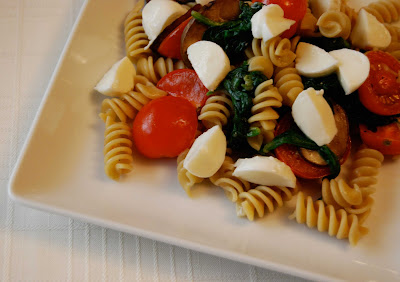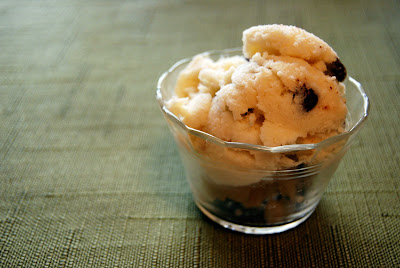 Blah blah blah, another pizza. But, oh, they are so simple to make! For this pizza, I used up the remainder of the yellow zucchini I had leftover from making zucchini bread yesterday by roasting zucchini slices along with a handful of cherry tomatoes. On top of the roasted zucchini and tomatoes I added some caramelized onions I had on hand that I had used as a burger topping over the weekend. To top it all off, I crumbled goat cheese over the top of the pizza. Though when previously making pizzas I've just brushed the crust with some olive oil, today I opted to brush the crust with some basil pesto. The resulting pizza was piled high with veggies and full of flavor -- definitely my kind of dinner.
Blah blah blah, another pizza. But, oh, they are so simple to make! For this pizza, I used up the remainder of the yellow zucchini I had leftover from making zucchini bread yesterday by roasting zucchini slices along with a handful of cherry tomatoes. On top of the roasted zucchini and tomatoes I added some caramelized onions I had on hand that I had used as a burger topping over the weekend. To top it all off, I crumbled goat cheese over the top of the pizza. Though when previously making pizzas I've just brushed the crust with some olive oil, today I opted to brush the crust with some basil pesto. The resulting pizza was piled high with veggies and full of flavor -- definitely my kind of dinner.
Whole Wheat Pizza with Pesto, Roasted Yellow Zucchini, Roasted Cherry Tomatoes, Caramelized Onions, and Goat Cheese
makes 8 servings
1. Preheat a pizza stone in the oven to 400 degrees.
2. Brush a whole wheat pizza crust with basil pesto.
3. Add a layer of roasted zucchini slices atop the crust. Add the roasted cherry tomatoes over the zucchini slices.
4. Spread caramelized onions evenly atop the zucchini and tomatoes.
5. Crumble goat cheese over the top of the pizza.
6. Bake in the oven for about 20 minutes.
7. After removing the pizza from the oven, let it cool for about 5 minutes before serving.
To make the roasted tomatoes and zucchini:
1 1/2 T olive oil
1 T brown sugar
1 t balsamic vinegar
pinch fine sea salt
8 cherry tomatoes
1/2 medium zucchini
1. Preheat the oven to 350 degrees.
2. Stir together the olive oil, brown sugar, balsamic vinegar, and fine sea salt in a small bowl.
3. Slice the zucchini into 1/4" rounds. Cut the cherry tomatoes in half.
4. Place the zucchini rounds and cherry tomato halves in an oven-safe baking dish.
5. Pour the prepared olive oil mixture over the veggies. Toss to evenly coat. Flip any tomatoes over so that they are seed-side up if necessary.
6. Roast in the oven for 45 minutes. About halfway through cooking, flip over the zucchini slices and bake for 25 minutes more.
7. Remove from the oven. Use immediately or refrigerate until ready to use.
For the caramelized onions:
1 medium onion, cut into 1/4" slices
2 T olive oil
1. Heat the olive oil in a skillet over medium heat. Add the sliced onions.
2. Stir occasionally during the first 15 minutes of cooking. The onions will soften and become translucent.
3. During the next 10 minutes of cooking, stir the onions about every minute or so to prevent them from sticking to the skillet bottom and burning.
4. The caramelized onions are done once the onions are lightly browned; the entire cooking process should take about 25-30 minutes.
 Over the weekend D and I found ourselves once again in Fort Collins. While at our requisite visit to Whole Foods, we picked up two organic whole chicken legs for a little barbecuing action. Since we were out of charcoal, I opted to cook the chicken legs in the oven with a generous helping of barbecue sauce leftover from my adventures in pulled pork a week or two ago. I served the bbq'd chicken legs over a bed of wild and basmati rice and also had some steamed broccoli florets (seasoned with salt and pepper, and covered with grated white cheddar cheese) on the side.
Over the weekend D and I found ourselves once again in Fort Collins. While at our requisite visit to Whole Foods, we picked up two organic whole chicken legs for a little barbecuing action. Since we were out of charcoal, I opted to cook the chicken legs in the oven with a generous helping of barbecue sauce leftover from my adventures in pulled pork a week or two ago. I served the bbq'd chicken legs over a bed of wild and basmati rice and also had some steamed broccoli florets (seasoned with salt and pepper, and covered with grated white cheddar cheese) on the side.







































